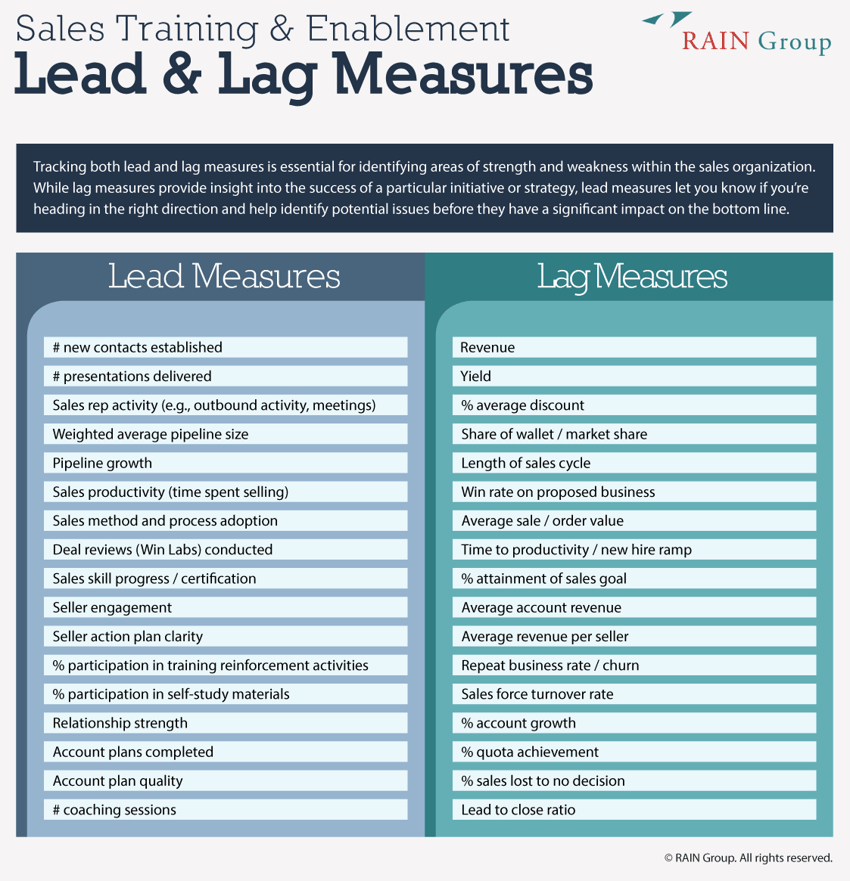Don’t be surprised to bump into discussions around metrics at any gathering of sales enablement professionals. Measuring the success of sales training and enablement initiatives is top of mind for these folks, and rightly so.
Or, as Amanda Cremone, Board Member at the Boston Chapter of the Sales Enablement Society and Enablement Director, Global Partnerships at Seismic, put it in a recent LinkedIn post on measuring impact, “Nobody cares more than enablement people. Nobody.”
Despite this, many organizations struggle to justify the return on investment (ROI) of their training programs and lack the systems and processes to regularly track the measures that indicate progress toward their goals. To address this, organizations must focus on both lead and lag measures.
How to Measure Sales Training and Enablement Metrics
Lead and Lag Measures
There are two types of metrics that sales and enablement leaders should be aware of: lead measures and lag measures. Lag measures are ultimate outcomes or results that are the consequence of a set of actions. These measures, such as win rate on proposed sales, average sale/order value, and percentage attainment of sales goal, provide insights into the overall success of the sales organization.
Lead measures, on the other hand, are predictive measures that are closely tied to the desired outcome. They're the specific activities or behaviors that, when performed consistently and effectively, are likely to drive the desired outcomes.
For example, the number of qualified leads generated by each seller per month, the number of discovery calls made per week, and the percentage of sales reps who complete a training program are all examples of lead measures.
Tracking both lead and lag measures is essential for identifying areas of strength and weakness within the sales organization. While lag measures provide insight into the ultimate success of a particular initiative or strategy, lead measures let you know if you’re heading in the right direction and help identify potential issues before they have a significant impact on the bottom line.
- Win rate on proposed sales
- Average sale/order value
- Time to productivity
- % attainment of sales goal
- Discounting/profitability of sales
- Average account revenue
- Average revenue per seller
- Repeat business rate/churn
- Length of sales cycle
- Sales force turnover rate
Common Lead Measures
- Weighted average pipeline size
- Pipeline growth
- Sales activity (e.g., outbound activity, meetings)
- Sales productivity (e.g., time spent selling)
- Sales method and process adoption
- Deal reviews (Win Labs) conducted
- Sales skill progress / certification
- Seller engagement
- Seller action plan clarity
Indeed, the list of sales metrics is long and can be overwhelming. Tracking too many measures adds complexity, along with a growing number of priorities. And having too many priorities leads to fewer priorities actually being achieved.

Keys to Tracking Measures
Once you’ve identified the key metrics to track, the next step is to effectively track them. Here are some best practices to help sales leaders ensure they’re tracking the right metrics and using them to drive meaningful improvements within their organizations.
Align Measures to Overall Strategy and Goals
The first step in tracking the right metrics is to align them with your overall sales strategy and goals. This means you need to understand the key outcomes you’re trying to achieve with your training and development initiatives and then identify the specific metrics that'll help you measure progress toward those outcomes.
For example, if your goal is to increase the win rate on proposed sales, you may want to focus on lead measures, such as the number of discovery calls made per week, the number of sales presentations made, and the percentage of opportunities that progress to the proposal stage.
Keep It Simple
The more complex your metrics tracking system, the less likely you are to use it effectively. Start small and keep it simple, focusing on the most critical metrics that align with your overall strategy and goals. Consider the tools you already have in place, such as your CRM system or sales reporting software, and find ways to leverage them to track your metrics. The simpler you keep it, the better success you'll have.
Get It to Three
While there are many metrics you could track, focusing on just a few key lead and lag measures can help simplify your tracking efforts and ensure you’re focusing on the most important metrics for your organization.
Identify the three core lag measures that are most important to you and tie them to your overall sales strategy. Then, identify three lead measures that indicate progress toward these goals. Track these measures closely and regularly to ensure you are making progress toward your sales goals.
Note: Tracking requires a lot of effort to make sellers accountable for inserting the data needed for tracking. Bad data in results in bad data out. Regular audits and follow up with sellers can go a long way to making sure you’re getting the accurate data you need.
Establish a Tracking Mechanism and Benchmark
Set up the tracking mechanism before you start and gather baseline data. There’s no point in creating a measure if you can’t track it. Furthermore, once you have baseline data, it'll be easy to compare and see improvements.
Track by Groups
Look at those participants who’ve been through specific training or part of a particular initiative and compare to those who have not. Often, we hear that it’s hard to attribute gains or increases to specific training. While it’s not an exact science, if you can compare the various groups and slice by those who’ve gone through training with those who haven’t, you can get a sense of the impact (assuming most other significant factors are equal).
Involve Other Departments
Sales cannot operate effectively if it’s a siloed function. Other departments can play a critical role in helping you track and measure the right metrics. Work with your CRM team, operations team, revenue team, demand gen, and others to get their input on what metrics are most critical to track. Engaging other teams can help significantly with streamlining the capture and ongoing tracking of measurements.
Track Regularly
Finally, track regularly. In a recent webinar we hosted, only 16% of participants said they always track business metrics related to training and only 27% do so most of the time. The remaining 57% track some of the time or never. Wherever you are on this spectrum, seek to move up.
With measures in place, organizations can make necessary adjustments, stay ahead of the constantly changing market, and prove the ROI and impact of their sales training and enablement initiatives.
As management guru Peter Drucker said, "What's measured improves."






